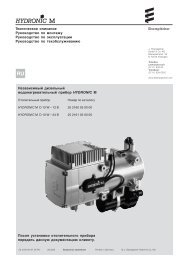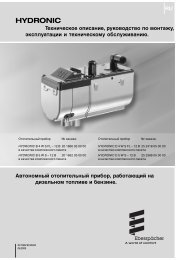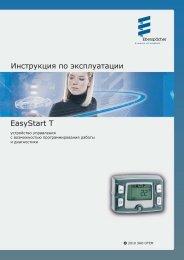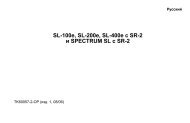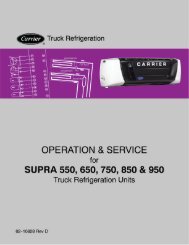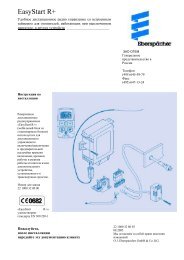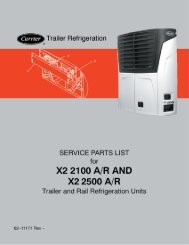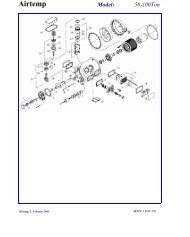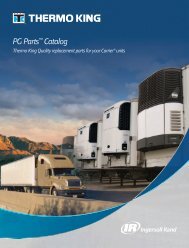SERVICE MANUAL for MODEL AirV Rooftop Air Conditioning Systems
SERVICE MANUAL for MODEL AirV Rooftop Air Conditioning Systems
SERVICE MANUAL for MODEL AirV Rooftop Air Conditioning Systems
- No tags were found...
Create successful ePaper yourself
Turn your PDF publications into a flip-book with our unique Google optimized e-Paper software.
passes into the accumulator. The accumulator isdesigned with the inlet tube delivering refrigerant to thebottom of the tank and the outlet tube taking refrigerant<strong>for</strong>m the top of the tank. This arrangement ensures thatonly vapor refrigerant is returned to the compressor,where the cycle repeats.When ventilation only is selected, the indoor fanfunctions to circulate air throughout the vehicle. Therefrigerant cycle will remain off.DISCHARGELIQUIDSUCTIONINDOOR COILCAPILLARYTUBESTRAINERREVERSING VALVEACCUMULATORCOMPRESSOROUTDOOR COILFigure 1 -15 Refrigerant Flow Schematic - Heat Pump - (Heat Mode)1.10.2 HeatingThe heating cycle is energized when the thermostat,located in the ceiling unit, calls <strong>for</strong> heat The systemcontrols are positioned <strong>for</strong> “reverse” refrigerant flow,with the compressor discharge delivered to the indoorcoil and liquid delivered to the outdoor coil. (SeeFigure 1--15.)The main components of the system are thecompressor, reversing valve, indoor coil, capillary tube,strainer, air-cooled outdoor coil, and the accumulator.The compressor raises the pressure and thetemperature of the refrigerant and <strong>for</strong>ces it through thedischarge line and reversing valve into the indoor coil.The indoor blower (fan) pulls inside air through thefilters, which remove particulate matter, and then passthe cleaned air through the indoor coil.The vehicle air (which is at a temperature lower than therefrigerant) passes over the outside of the coil tubes.Heat transfer is established from the refrigerant (insidethe tubes) to the vehicle air (flowing over the tubes). Thetubes have fins designed to improve the transfer of heatfrom the refrigerant gas to the air; this removal of heatcauses the refrigerant to liquefy, thus liquid refrigerantleaves the coil and flows through the strainer to theoutdoor coil. The strainer removes any impurities withinthe refrigerant system.The capillary tube meters the flow of liquid refrigerant tothe outdoor coil. As the refrigerant flows through thecapillary tube, there is a reduction in pressure andtemperature.The low pressure, low temperature liquid that flows intothe outdoor coil tubes is colder than the outdoor air thatis circulated over the tubes. Heat transfer is establishedfrom the outdoor air (flowing over the tubes) to therefrigerant (flowing inside the tubes). The outdoor coiltubes have aluminum fins to increase heat transfer fromthe air to the refrigerant.The transfer of heat from the air to the low temperatureliquid refrigerant in the outdoor coil causes the liquid tovaporize. This low temperature, low pressure vaporpasses into the accumulator. The accumulator isdesigned with the inlet tube delivering refrigerant to thebottom of the tank and the outlet tube taking refrigerant<strong>for</strong>m the top of the tank. This arrangement ensures thatonly vapor refrigerant is returned to the compressor,where the cycle repeats.When ventilation only is selected, the indoor fanfunctions to circulate air throughout the vehicle. Therefrigerant cycle will remain off.1.11 FREQUENTLY ASKED QUESTIONS ANDANSWERS1. Q) -CanaHeatStripbeaddedtoa(CoolOnly)Freelow Unit?A) No. The addition of a heat strip requires anew ceiling assembly (Pt# 99--00469--02). TheMaster Switch and Thermostat have additional functionsto accommodate heat. The Thermostat is dualposition (SPDT) contacts as opposed to single position(SPST).2. Q) - Why is the plug on the heat strip too short toreach the connector?A) The heat strip is secured <strong>for</strong> shipping purposes.Remove the heat strip, flip it over and mount itin the airflow. When properly installed in this mannerthe interface cable will reach.10/091--17T--298






